Explore a variety of nutritious and kid-friendly meals that can be incorporated into daycare menus for breakfast, lunch, and snack times.
Planning a daycare menu can be a challenging task, especially when you’re trying to strike a balance between nutrition, taste, and children’s preferences. This article is your one-stop solution, providing a plethora of breakfast, lunch, and snack ideas that are not only healthy and delicious but also cater to the diverse tastes of little ones.
From fruit-filled breakfasts and protein-packed lunches to fun and finger-friendly snacks, we’ve got you covered. Dive in to explore a comprehensive guide that ensures your daycare menu will never be dull or lacking in nutritional value.
Scrambled Eggs and Toast

Crafting this classic meal starts by whisking eggs until the yolks and whites are fully incorporated, adding a touch of milk will result in fluffier eggs. Melt a pat of butter in a non-stick pan over medium heat, pour in the eggs, and stir gently. The key is to let the eggs cook undisturbed until they start to set around the edges, then stir from the outside in, which creates large, soft curds. A sprinkle of salt and pepper enhances the taste.
Toast serves as a complementary, hearty element. Choose whole grain bread for an extra fiber boost. Lightly buttered or served with a side of jam, it brings variation in texture and taste complementing the eggs.
Together, eggs and toast provide a balanced meal of proteins, carbohydrates, and fats. It’s a quick, easy-to-make dish that keeps youngsters energetic until the next mealtime. Colorful fruits or vegetables on the side can add a visual appeal and additional nutrients, creating a well-rounded, inviting breakfast.
Pancakes and Bananas
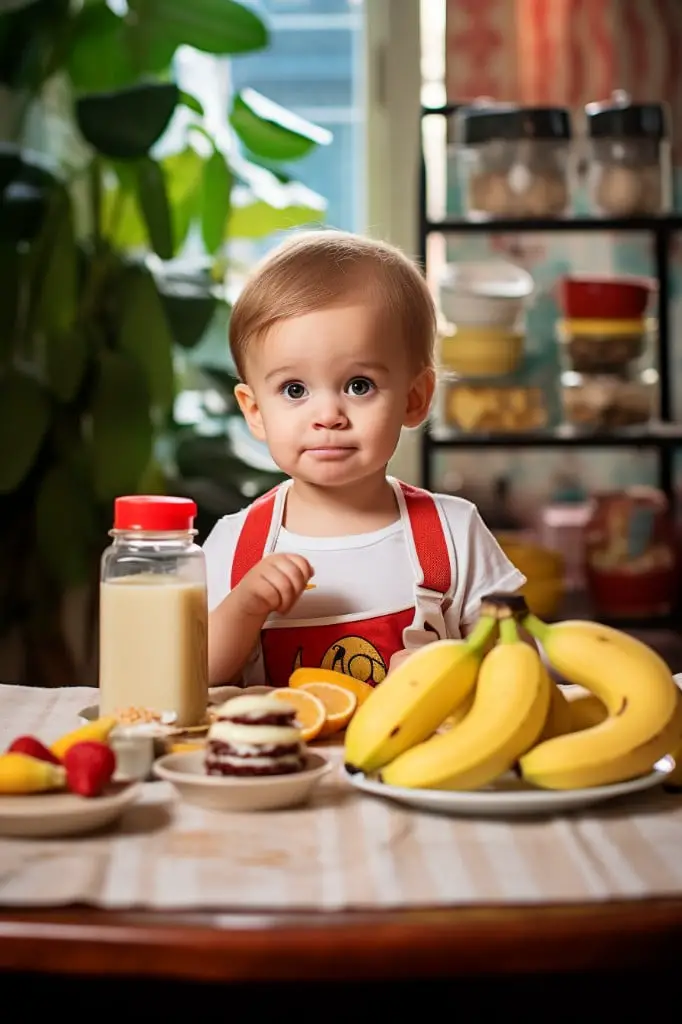
Packed with versatile flavors, this combination delivers more than just a tasty meal. It entails a nutritious assortment of carbohydrates, proteins, and fruits. The key component, pancakes, provides the much-needed energy for the day through carbohydrates. Opting for whole wheat pancakes intensifies the fiber content, ensuring longer satiety and healthier digestion.
On the other hand, bananas come into play to balance the meal with a touch of sweetness and a burst of essential vitamins. Rich in potassium, fiber, vitamin C, and vitamin B6, they aid in maintaining a healthy heart and robust immunity.
Tip: Just ensure the pancakes are not dripping with syrup – a light drizzle or some honey might be healthier. For the bananas, remember, fresher is better. Slice them up just before serving to preserve the vitamins and prevent them from turning brown. Adding a sprinkle of cinnamon can take the flavor profile up a notch, more so during winter months when its comforting warmth is desirable.
Oatmeal With Berries

A warm, hearty bowl of oatmeal serves as an excellent source of whole grains. It’s not only fiber-rich but also provides significant protein to get children’s day started right.
Adding a variety of berries, such as blueberries, raspberries or strawberries, introduces a sweetness without added sugars. These berries carry essential nutrients, vitamins and antioxidants which promote overall health.
When preparing, use either water or milk for the oatmeal depending on personal preference or dietary needs. Once cooked to the desired consistency, mix in a handful of fresh or frozen berries. Freezing berries when they’re in peak season ensures you have a nutritious topping all year round.
Remember to consider the age of children when serving size is concerned.
Oatmeal with berries offers an easy, nutritious and highly adaptable breakfast choice. It promotes good health and lifelong positive eating habits among children. Plus, it adds a colorful and tasty start to their day.
Cheese and Fruit Kabobs
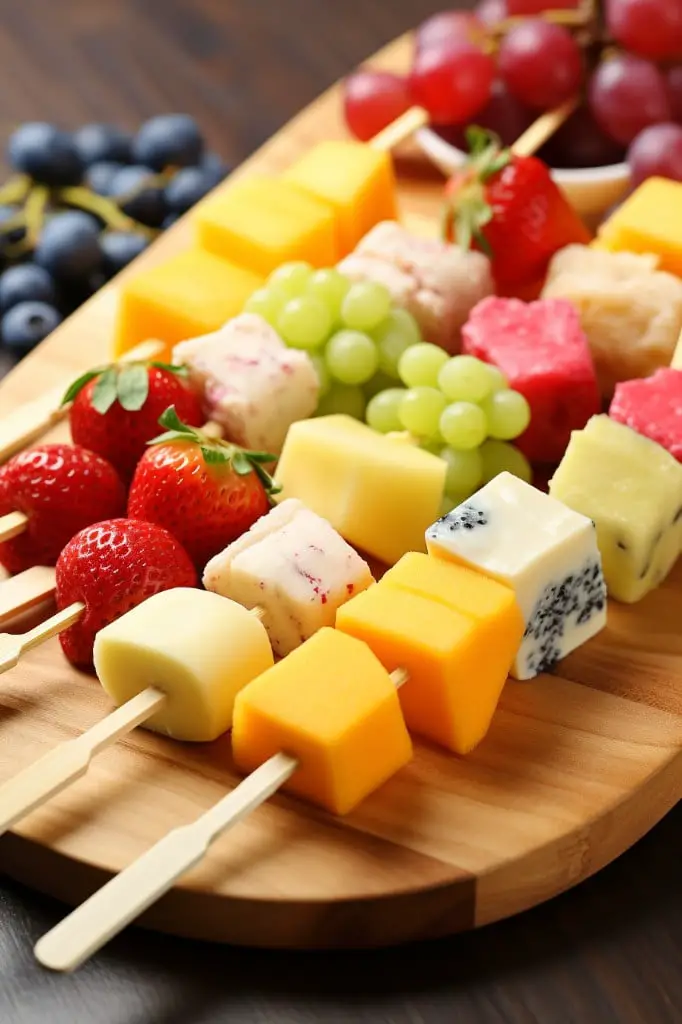
One of the most appealing aspects of this snack is its variety. Cheese and fruit kabobs provide an opportunity to mix and match different kinds of cheese and fruits, combining flavors in unique ways. For instance, you could use cheddar with green grapes, or pair mozzarella with tomato and basil for an Italian spin.
Preparation is unexpectedly simple: just cut your chosen cheese and fruit into bite size pieces and slide them onto a skewer. It’s an activity that even children can participate in, promoting active involvement in their own nutrition.
This snack also has nutrition covered. Cheese offers an excellent source of calcium and protein, essential for growing bodies. Simultaneously, fruits serve up valuable vitamins and fiber. Plus, the vibrant colors can make the kabobs visually exciting for kids – a creative way to encourage them to eat healthily.
Remember, safety first. If you’re making these for younger children, consider using straw or a Popsicle stick instead of a sharp skewer. Also ensure the fruit and cheese pieces are sized appropriately to reduce the risk of choking.
Greek Yogurt With Granola
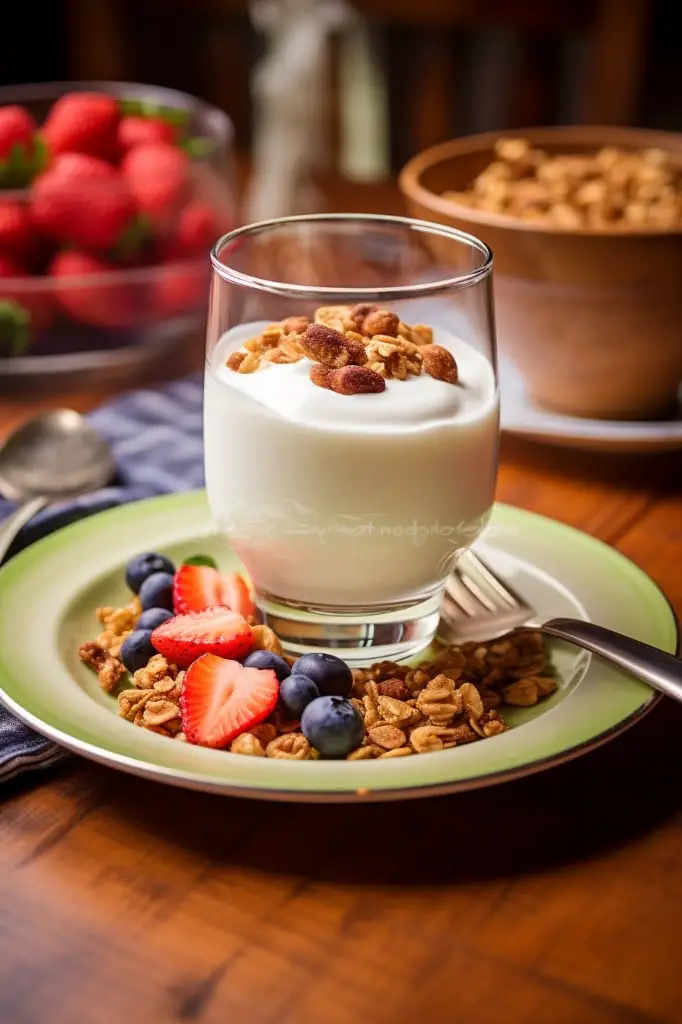
Moving forward, let’s delve a bit more into one of the enticing breakfast options. Pairing the high protein, gut-friendly Greek yogurt with a hand-picked selection of granola can offer both a taste sensation and a nutritious kick-start to the little ones’ day.
1. Nutritional Value: High in protein and packed with probiotics, Greek yogurt aids in digestion and keeps children feeling full longer. Add granola to this, you get fiber, iron, and healthy fats, providing energy for their active explorations.
2. Adaptability: Make the dish even more engaging by allowing children to customize their bowl. Offer a variety of granola blends and encourage them to choose their favorite.
3. Sensory Exploration: By creating a variety of textures from creamy to crunchy, and sweet to tangy, this harmonious pairing tantalizes the taste buds and keeps little eaters interested.
4. Easy Preparation: The simplicity of this dish wins points with caregivers. Preparing it takes only a few minutes in the morning – lay out the Greek yogurt, sprinkle granola on top, add a drizzle of honey or some fresh fruit, and it’s ready to serve.
5. Allergen Friendly: Most Greek yogurts are gluten-free and both ingredients can easily be swapped for non-dairy or nut-free alternatives if required.
Overall, this delightful combination of Greek yogurt and granola provides a wealth of opportunities for daycare menus, both in terms of nutritional value and engaging young taste buds.
Vegetable Pasta
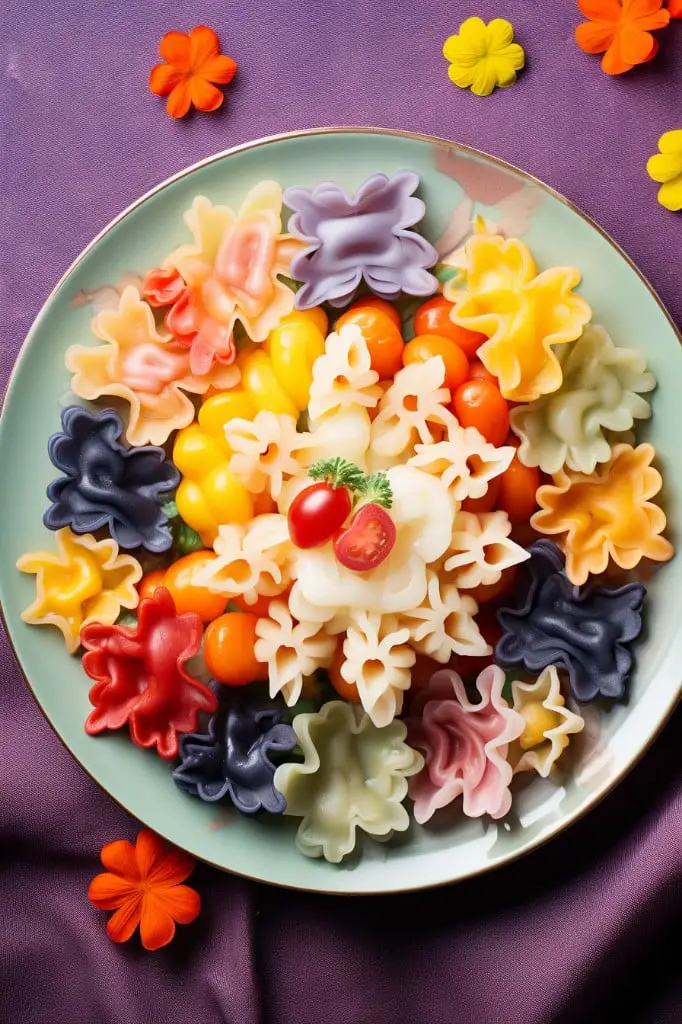
Packed with essential vitamins, minerals, and fiber, a colorful array of vegetables provides a nourishing base for this hearty dish. Opting for whole-grain pasta introduces a delicious nutty flavor while also boosting the fiber content, aiding in digestion, and providing a long-lasting source of energy for active little ones.
For a toddler-friendly version, opt for mini shapes like fusilli or farfalle. They are easier to grab with tiny fingers or a fork and more fun to eat.
One neat trick is hiding vegetables in the marinara sauce. Puree cooked carrots, spinach, or even butternut squash and mix it with your tomato sauce. Children won’t even realize they’re eating their vegetables.
Adding a sprinkle of cheese not only elevates the taste but also introduces a good source of calcium important for growing bones. If your daycare has dietary restrictions, opt for vegan cheese for the same creamy effect.
Swapping in pesto sauce made from fresh basil, garlic and nuts periodically also adds a welcome change.
Remember, the key to a successful vegetable pasta is to keep it vibrant with vegetables, whole-grain pasta, and a flavorful sauce!
Turkey and Cheese Roll-ups
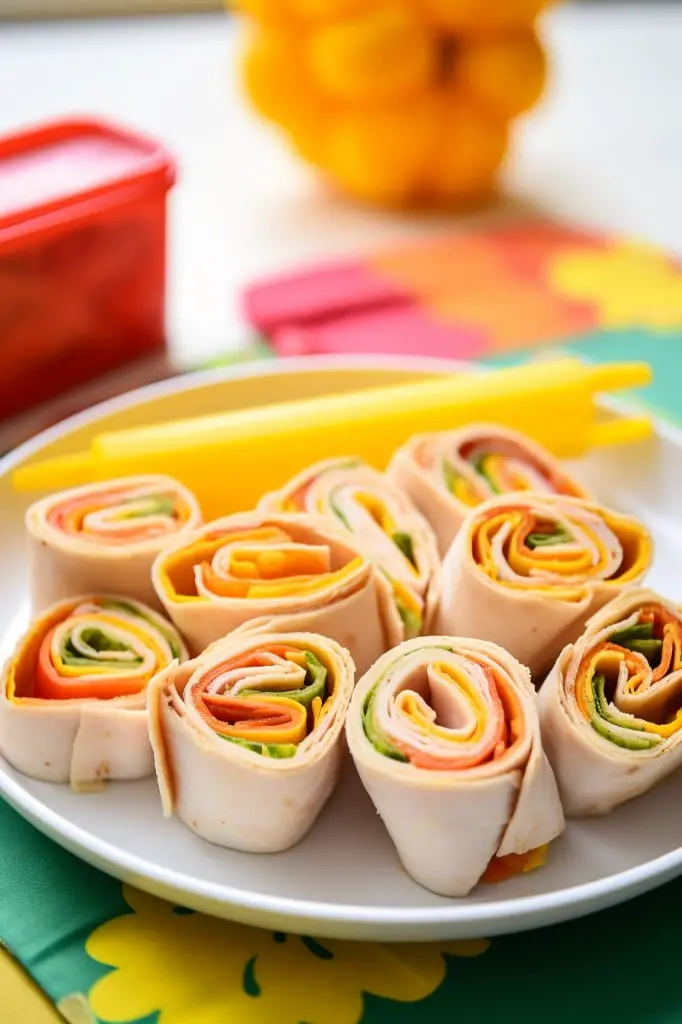
For a nutritious yet enticing lunch option, look no further than Turkey and cheese roll-ups. Combining wholesome ingredients with an enjoyable format, these roll-ups are popular among the daycare crowd.
To create them, use a whole grain tortilla as the base. Not only does it add a fiber boost, but it also holds everything together nicely.
Add a slice of lean turkey, providing necessary protein for children’s growth. Next, layer a slice of cheese for calcium, ensuring the proper development of bones.
For extra nutrition, thinly sliced cucumbers or bell peppers can be added. Rolling it up makes it not only fun to eat, but also manageable for small hands.
Remember to cut them into bite-size pieces to prevent choking and facilitate easier eating. For an allergy-sensitive version, use a cheese substitute and check for gluten-free tortillas.
In essence, turkey and cheese roll-ups tick all the boxes for a delicious, nutritious and kid-friendly lunch. Plus, the ingredients can easily be swapped out to cater to dietary restrictions and personal preferences.
Chicken and Vegetable Stir-fry
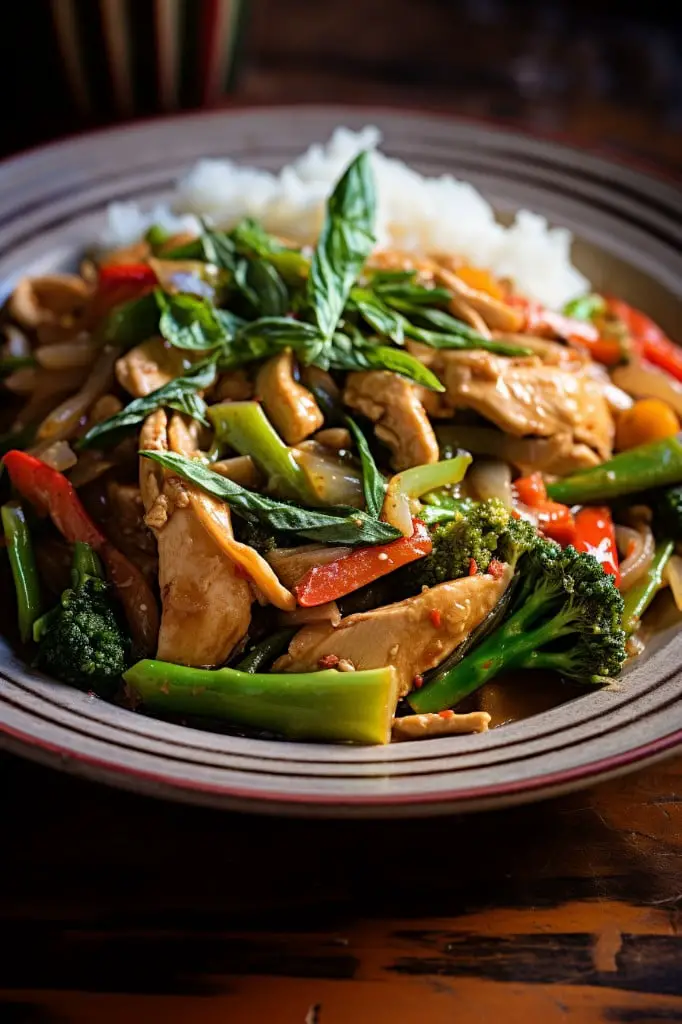
In terms of preparation, the charm of this dish lies in the simplicity. First, thinly sliced chicken breast is stir-fried with vibrant, nitrate-rich vegetables such as bell peppers, broccoli, carrots, and snow peas. Each component maintains its own unique crunch and flavor while contributing to the overall symphony of tastes.
Understanding its nutritional importance is crucial. The chicken provides a lean source of high-quality protein, essential for muscle growth and maintenance. The variety of colorful vegetables provides an array of vitamins, minerals, and dietary fiber, supporting digestive health and offering antioxidant benefits.
Moreover, the adaptability of this dish is a huge advantage. It can cater to dietary restrictions and preferences with a few straightforward swaps. For example, tofu can replace chicken for vegetarian children, and the veggies can be interchanged based on seasonality and availability.
Furthermore, in terms of serving and presentation, adding a side of brown rice or quinoa enhances the fiber content. Besides, the vibrant, appealing colors are an effective way to pique the interest of the children and stimulate their appetite.
Lastly, ensure to keep the seasoning mild. Less sodium is better, considering the young palates. The beauty of this dish is the natural harmony of the ingredients, hence, excessive seasoning is unnecessary.
Ham and Cheese Quesadilla

Creating this dish starts with whole grain tortillas, which are not only rich in fiber but also add a nutty flavor that enhances the meal.
The filling is a healthy blend of lean ham and a moderate amount of cheese, ensuring that children receive their needed protein intake without an excess of fat.
For an added burst of color and nutritional punch, greens like spinach or finely chopped bell peppers can be included.
The ingredient assembly is integral, ensuring an even spread for a perfect bite every time.
A final grilling gives the quesadilla its satisfying crispy exterior.
Remember to keep the heat moderate to allow the cheese to melt thoroughly without burning the tortilla.
This meal doesn’t require elaborate utensils, making it easy for little hands to manage.
The combination of flavor, texture, and nutrition make it a great addition to any daycare menu.
Mini Pizzas With Peppers
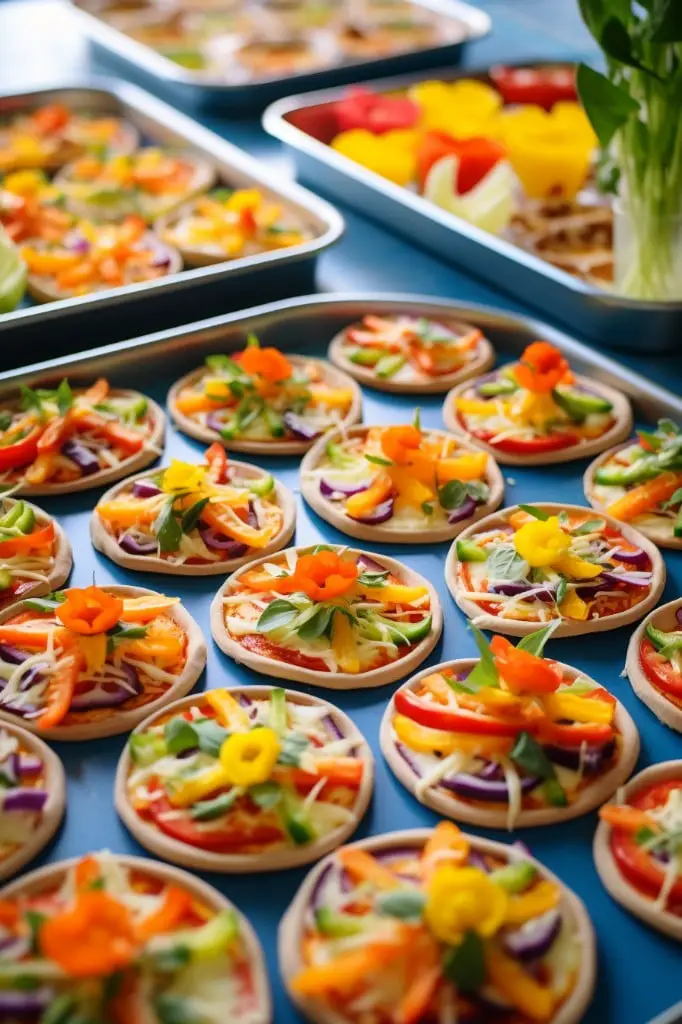
Crafting these nutritional delights involves topping whole grain English muffins with marinara, shredded mozzarella, and a colorful array of diced bell peppers.
A few minutes in the oven is enough to meld these flavors beautifully.
These miniature gourmet treats offer a balanced combination of protein, vegetables, and fiber, while brightening up any mealtime with their vibrant colors.
Given their compact nature, they’re easily handled by little fingers, encouraging self-feeding.
Plus, involving the kids in their creation cultivates culinary interest and appreciation for healthy ingredients at a tender age.
Quinoa Salad With Veggies

Quinoa salad boasts high protein, nutritious vegetables, and the bonus of it being an all-in-one dish. Preparing this for a daycare menu provides children with a healthy and delicious lunch choice.
Cooking quinoa is straightforward: bring it to a boil with water in a 1:2 ratio, simmer until tender – approximately 15 minutes. This grain has a mild flavor, excellent for pairing with vibrant veggies.
A rainbow assortment is a wonderful approach, with bell peppers, cherry tomatoes, cucumbers, corn, and an optional sprinkle of feta. This array not only creates a visually appealing meal but also incorporates a variety of nutrients.
For the dressing, a simple vinaigrette using olive oil, lemon juice, and an option of adding honey for sweetness, can be balanced with parsley, and salt and pepper to taste. Prepare in advance and toss the dressing with the quinoa and veggies before serving, allowing flavors to meld.
Remember, this salad is flexible. It can be adapted to suit fussy eaters by removing or substituting specific vegetables. Ultimately, it’s a nutritious, adaptable, and satisfying lunch for busy daycare days.
Whole Wheat Wraps With Hummus and Cucumber
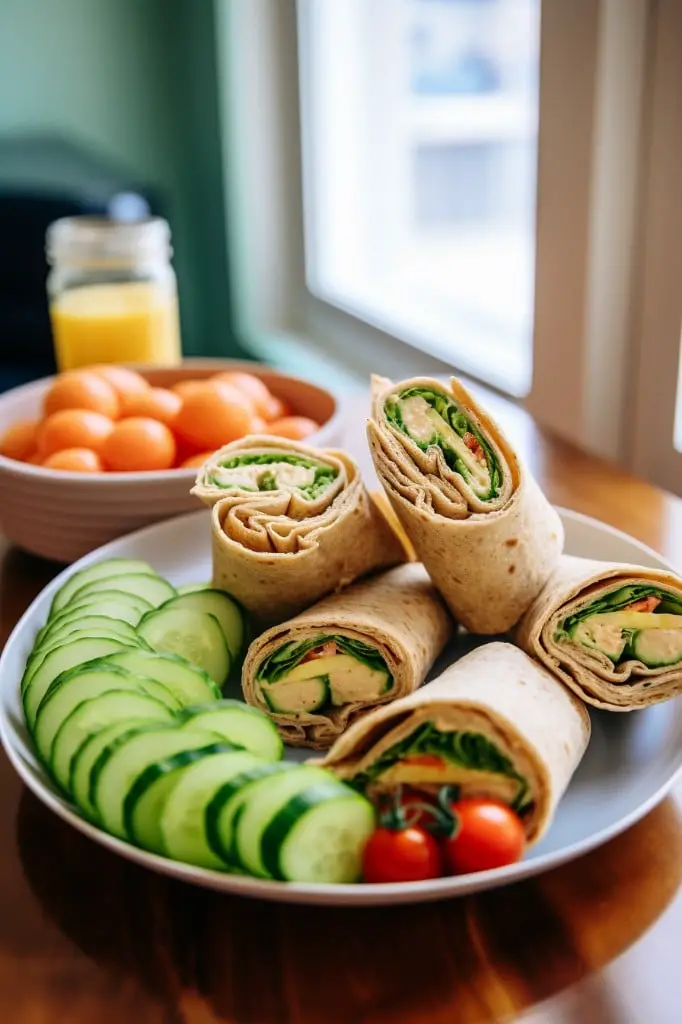
A delightful combination of wholesome nutrition and appetizing flavor, this simple meal includes dietary fiber, protein, and a crisp addition of freshness – ideal for any lunchbox.
Packed with the fiber and minerals of whole wheat, the wraps make a nutrient-dense base.
A spread of hummus adds a burst of protein and essential amino acids, promoting muscle strength and growth.
Cucumber slices introduce a juicy, crunchy textural contrast, while providing hydration and vitamin K.
Preparing this meal is as easy as assembling the ingredients on the wrap and rolling it up.
For variation and extra nutrients, consider adding a sprinkle of chia seeds or flaxseeds over the hummus layer or adding in other crunchy veggies such as bell peppers or shredded carrots.
Sweet Potato Fries

Sweet potato fries make a fantastic option for several reasons. First, they introduce children to a nutritious root vegetable rich in fiber, vitamins, and antioxidants. Additionally, their natural sweetness is often palatable to even finicky eaters, which makes them an ideal item for daycare menus.
Preparing this snack is also quite simple. Begin with peeling and slicing the sweet potatoes into fries-like shapes. Toss them lightly in olive oil, sprinkle some salt and pepper, and arrange them on a baking sheet. For an extra layer of flavor, you could add a sprinkle of cinnamon or cumin. Bake until crispy and golden.
For variation, consider providing a healthy dip on the side. For instance, Greek yogurt with a little garlic and herbs can create a savory contrast to the sweetness of the fries.
Not only are sweet potato fries delicious and healthy, but they also deliver a vibrant pop of color to a child’s plate, making mealtime visually appealing and fun!
Baked Zucchini Chips
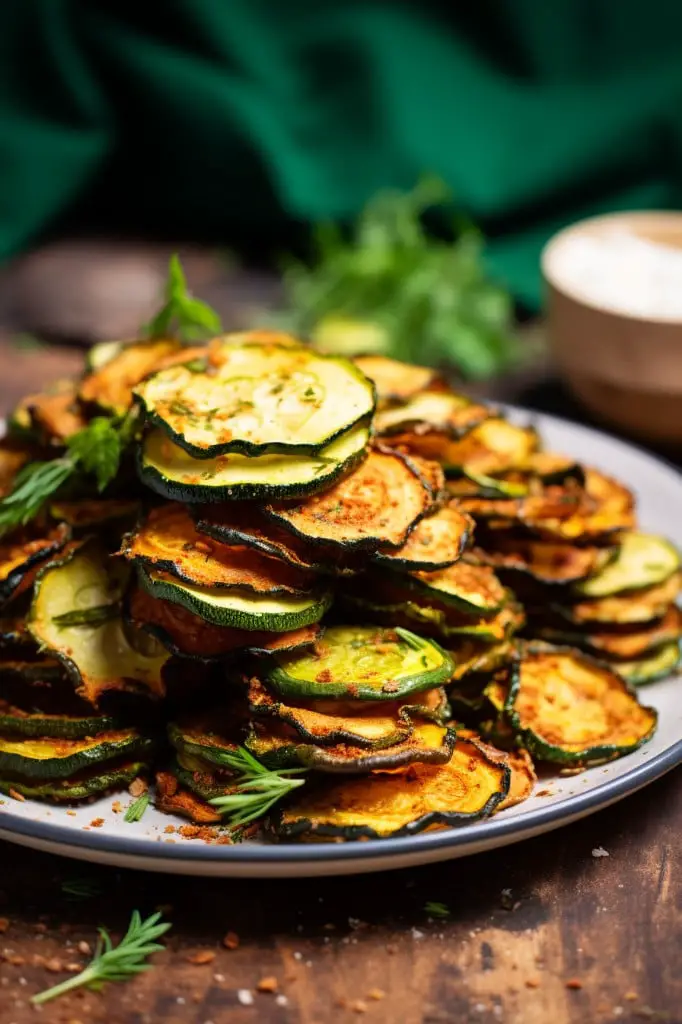
Baked zucchini chips are a delectable, nutritious snack choice for your daycare menu. Their preparation is as simple as it is impressive.
1. Choose a fresh zucchini. Look for a firm, unblemished specimen. The size doesn’t matter as much, since you’ll be slicing it into thin rounds.
2. Slice and season. Using a mandoline or sharp knife, cut even, thin slices. Lightly sprinkle with sea salt and your choice of herbs or spices. Avoid over-salting as it can draw out the moisture and make your chips soggy, not crispy.
3. Bake to perfection. Arrange on a baking sheet lined with parchment paper. A moderate oven temperature—around 225 degrees Fahrenheit—will do the trick. Slow and low is the key to achieving the perfect crispness without burning.
4. Serve with a healthy dip. For added flavor, consider a homemade dip. A yogurt-based dill or cucumber sauce is a great match.
Remember to always let the chips cool completely before serving. Not only will this give your chips the best texture, but it will also make them safer for the little ones to eat. They’re not only fun but also offer a creative way of sneaking in some valuable nutrients into the daily diet of the kids.
Apple Slices and Peanut Butter
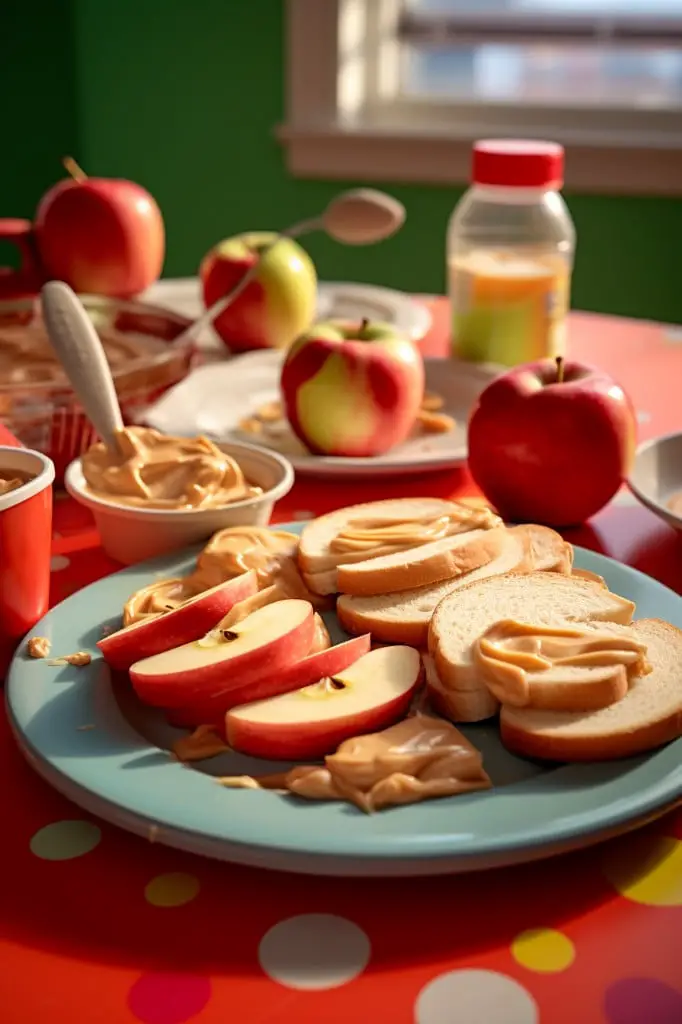
Harnessing the natural sweetness of apples against the creamy richness of peanut butter creates a snack that is hard to resist for children. In addition, this combination offers a nutritional powerhouse with multiple health benefits such as:
- 1. Balanced nutrition: An apple provides essential fibers, vitamins A, C and E, while peanut butter offers wholesome fats and protein, creating a well-rounded snack.
- 2. Easy to prepare: With just simple slicing and spreading, preparation becomes effortlessly quick and manageable even with a large number of kids.
- 3. Versatility: This snack can be tweaked according to personal preferences. Different apple varieties can bring in a mix of sweet and tart flavors along with varying peanut butter, perhaps chunky for a bit of crunch or flavored for additional tastes.
- 4. Allergen alternative: If allergies are a concern, institutions can substitute peanut butter with any variety of nut-free butter options.
Keep in mind that serving sizes should be mindful of a child’s small tummy, with thin apple slices and a thin spread of peanut butter being sufficient.
Fruit Salad With Yogurt Dip
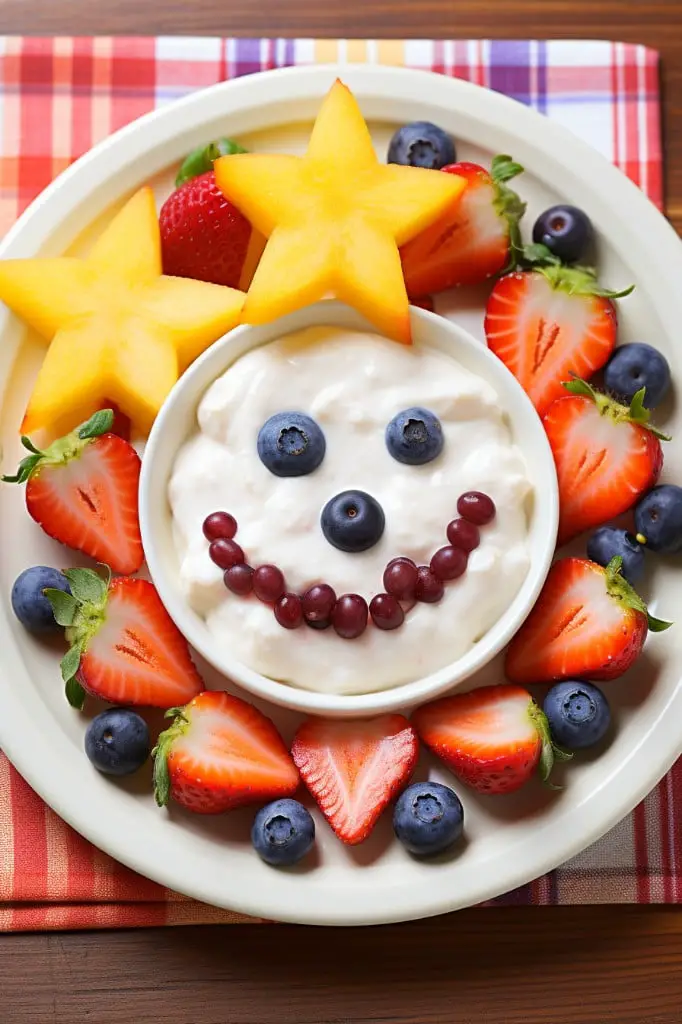
A vibrant mix of juicy strawberries, ripe bananas, and crisp apples, complemented by other seasonal fruits, adds a refreshing, healthy component to the daycare menu. Remember, chopping the fruits into bite-sized pieces makes it easier for the little ones to enjoy.
The yogurt dip, creamy and light, provides the necessary probiotics for the children’s gut health. Opting for a natural, unsweetened yogurt is key to keeping this snack as wholesome as possible. This chills nicely in the refrigerator, allowing convenience in preparation ahead of time. Adding a smidge of honey to the dip can satisfy the sweet tooth without resorting to refined sugar.
Serve this and witness the children’s delight in dipping their fruits into the yoghurt, an engaging way of serving these nutritional powerhouses. Make sure to take into account any food allergies among the children, like dairy in the yogurt or strawberries in the salad.
Carrot Sticks and Hummus

Let’s delve deeper into what makes this combination so invigorating. Both components of this snack are rich in vital nutrients. Carrots are packed with vitamin A, essential for eye health, while hummus, made from chickpeas, is a great source of protein and dietary fiber.
Preparing this snack is incredibly simple. All you need to do is chop up fresh carrots into sticks and pair them with a scoop of creamy store-bought hummus. Alternatively, you might prefer to make your hummus from scratch. A fresh, homemade batch can add a delightful touch for the children, and it gives you the flexibility to adjust the flavors as needed.
To keep things more appealing for children, consider offering a variety of colored carrot sticks – orange, purple, yellow, and white. This not only adds a fun twist but also expands their palette. Moreover, incorporating different hummus flavors can work wonders too. Varieties like roasted garlic, red pepper, or even a mild spicy hummus can be a nice adventure for their taste buds.
Remember to consider allergies and dietary restrictions the children might have – a critical practice in any group feeding scenario. If chickpeas or sesame seeds (main ingredients of hummus) are a concern, there are numerous other vegetable dips and spreads that are equally nutritious and kid-approved.
This snack’s nutritional value, paired with its simplicity and versatility, has propelled it high on the list of favorites for daycare menus.
Mini Bagels With Cream Cheese

These bite-sized morsels have the perfect balance of soft bread and creamy cheese. Their diminutive size is ideal for little hands to grip and their portion control benefit is great too.
To add an element of fun, you can cut these mini bagels into interesting shapes using a cookie cutter. This can induce excitement amongst kids during meal times.
It’s important to note that cream cheese offers a good amount of protein, which is necessary for a child’s growth. Moreover, choose whole grain bagels whenever possible, as they are full of fibers and help in digestion.
Lastly, add a little variety by including different types of cream cheese, such as those flavored with vegetables or fruits. This will ensure the meal stays interesting and the children are exposed to different flavors.
Rice Cakes and Avocado
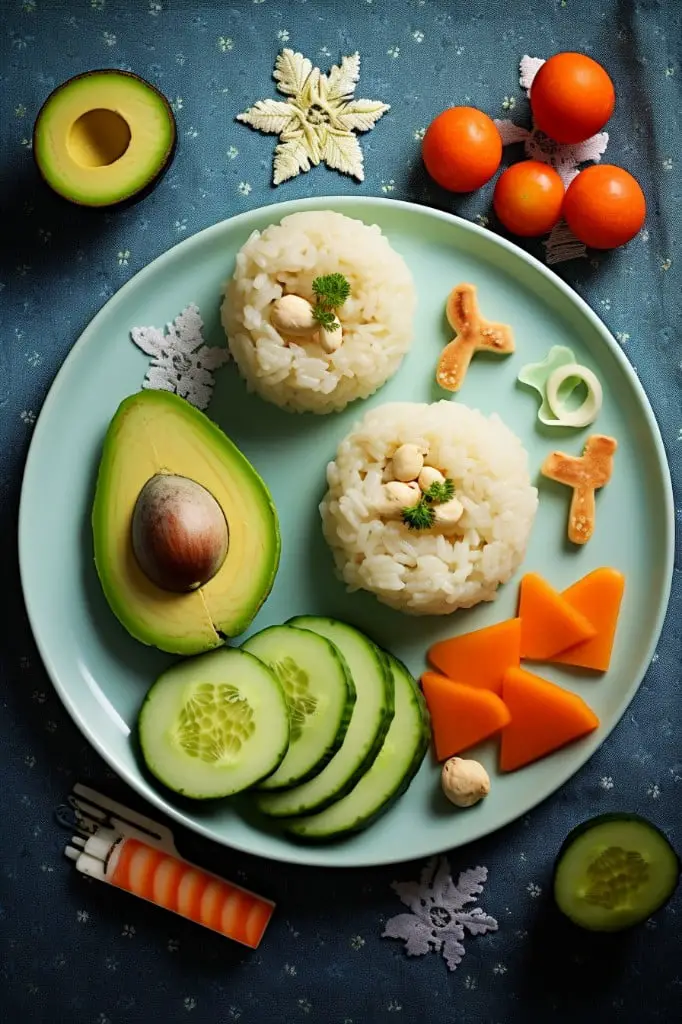
Offering a crisp contrast in textures and delightful blend in flavors, this combination is not just enjoyable but beneficial too. Rice cakes provide a light, satisfying crunch and are an excellent source of carbohydrates, lending energy for those fun, action-packed daycare activities. Their lean nature makes them a suitable base for various toppings, and in this case, avocado.
Avocado, often referred to as ‘nature’s butter’, lends luscious creaminess to the pairing. Packed with heart-healthy monounsaturated fats and fiber, it supports not just taste but also overall health. Avocado also boosts brain health, necessary for a child’s cognitive development.
Assembling is simple – just a light spread of ripe, mashed avocado on the rice cake. With a dash of seasoning, it can be customised to one’s liking. This snack models a perfect fusion of taste, nutrition, and simplicity. Its single-bite size makes it easily manageable for kids, limiting messiness while maintaining the enjoyable factor.
Remember: Variety is key to catering to youthful palates, so feel free to swap out avocado with other nutrient-dense spreads like almond butter or cream cheese, adding new layers of flavor to this delightful snack. It may also encourage adventurous eating habits, which can often be beneficial in the long run.
Whole Grain Muffins and Milk
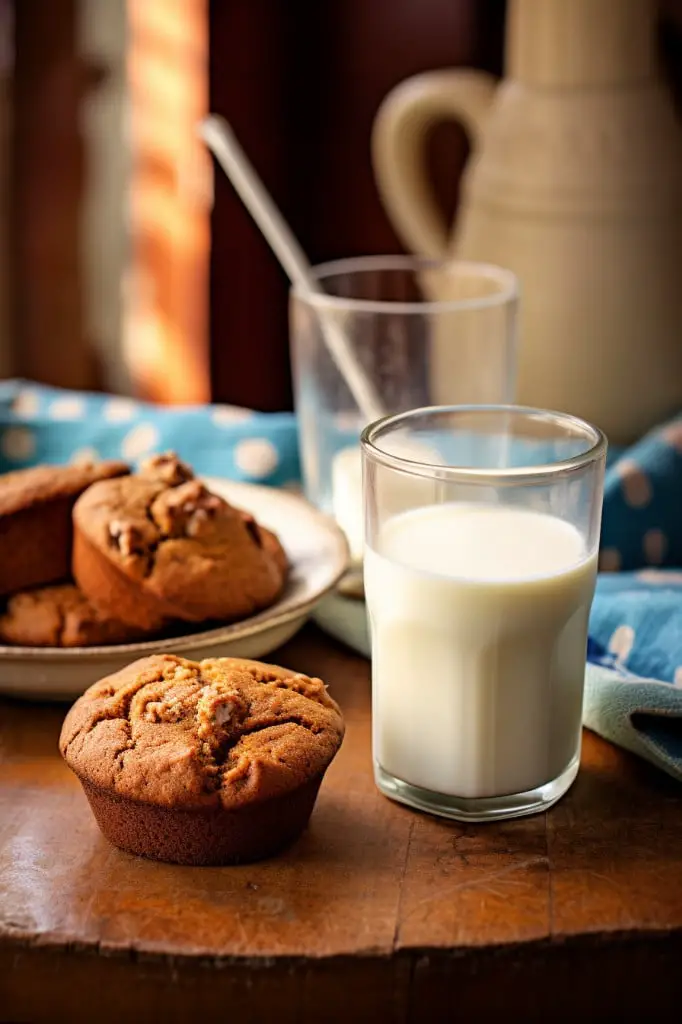
Whole grain muffins serve as a significant source of fiber, which aids in digestion and keeps the stomach feeling fuller for an extended period. By using whole grains instead of refined flour, muffins become a great option for maintaining energy levels throughout the day.
Muffins can be baked in batches and stored for later use without a loss in quality, making them a perfect time-saving solution for busy weekdays. They can be individually wrapped and frozen to preserve freshness, and easily defrosted overnight or warmed up in the microwave, ensuring a convenient, nutritious, and appetizing breakfast or snack is always within reach.
Complementing this with milk provides an additional layer of nutritional benefits. Milk is abundant in calcium, which is crucial for bone health, particularly in growing children. Moreover, it contributes to the daily protein requirement, supporting muscle development and repair.
For added variety and nutritional content, consider integrating fruits or seeds such as blueberries, grated apples, or flax seeds into the muffin recipe. You introduce an element of surprise and excitement into each bite, along with additional vitamins and fiber.
With the right balance of flavors, the combination of whole grain muffins and milk can certainly help turn any day in the daycare into a delightfully nourishing experience, supporting children’s health and readiness to learn.
